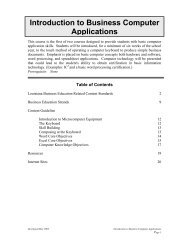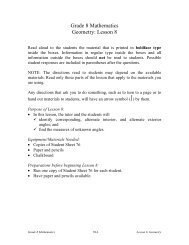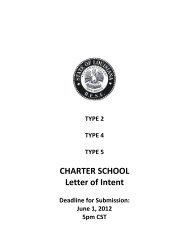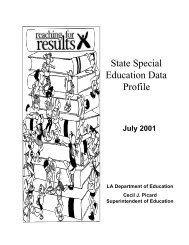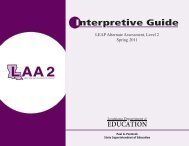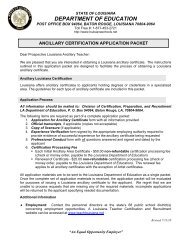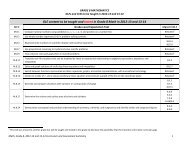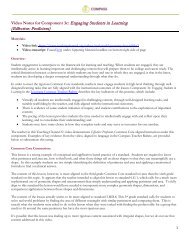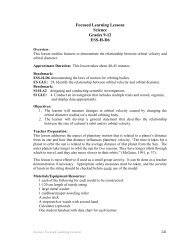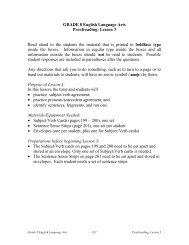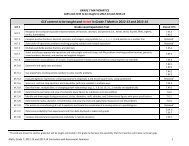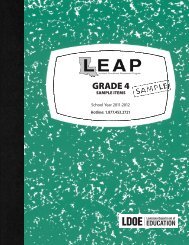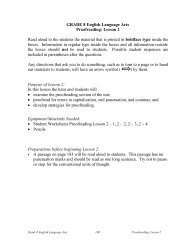- Page 2 and 3: LOUISIANA DEPARTMENT OF EDUCATION 1
- Page 7 and 8: THE SCHOOL IMPROVEMENT PROCESS: •
- Page 9 and 10: FEDERAL REGULATIONS FOR NO CHILD LE
- Page 11 and 12: NCLB - SEC. 1116. ACADEMIC ASSESSME
- Page 13 and 14: SCHOOL IMPROVEMENT PLAN CROSSWALK T
- Page 15 and 16: Ten Components of a Schoolwide Prog
- Page 17 and 18: Ten Components of a Schoolwide Prog
- Page 19 and 20: LOUISIANA STATE LEGISLATURE STATUTE
- Page 21 and 22: SCHOOL IMPROVEMENT PROCESS IN LOUIS
- Page 23 and 24: THE CYCLE OF THE SCHOOL IMPROVEMENT
- Page 25 and 26: ROLES AND RESPONSIBIILTIES IN THE P
- Page 27 and 28: Role SIT (together with the DAT and
- Page 29: RECOMMENDED TIMELINE FOR MEETING TH
- Page 32 and 33: GUIDING QUESTIONS 1. How do student
- Page 35 and 36: GOALS A goal states the general edu
- Page 37 and 38: SAMPLE GOAL(S) FORMAT (Select no mo
- Page 39 and 40: OBJECTIVES An objective is an expre
- Page 41: OBJECTIVES Resources Conzemius, A.
- Page 45 and 46: • To decrease the number of stude
- Page 47 and 48: 13. What resources (i.e., time, mon
- Page 49 and 50: 5. Meaningful Engaged Learning (MEL
- Page 52 and 53: ACTION PLAN An action plan is a det
- Page 54 and 55: • Percentage of students attainin
- Page 56: ACTION PLAN Resources Sample School
- Page 59 and 60: NATIONAL STAFF DEVELOPMENT COUNCIL
- Page 61 and 62: 6. How does the school or district
- Page 63: Murphy., & Lick, D. (1998). Whole f
- Page 66 and 67: 6. How are school improvement activ
- Page 68 and 69: Resources Edited by Hutchins, Darcy
- Page 70: Family and Community Involvement Re
- Page 73 and 74: STEPS TO TAKE Implementing the Comp
- Page 75 and 76: STEPS TO TAKE Professional Developm
- Page 77 and 78: Special Education • General Educa
- Page 79 and 80: Theatre American Alliance for Theat
- Page 81 and 82: Hannaford, Carla. (1995). Smart mov
- Page 83 and 84: U.S. Department of Education. No Ch
- Page 85: An IEP Team’s Introduction to Fun
- Page 88 and 89: 5. How has the school improvement t
- Page 91 and 92: COMPREHENSIVE NEEDS ASSESSMENT Guid
- Page 93 and 94:
Rubric: Acceptable Not Acceptable V
- Page 95 and 96:
SCIENTIFICALLY BASED RESEARCH STRAT
- Page 97 and 98:
ACTION PLAN - PROFESSIONAL DEVELOPM
- Page 99 and 100:
Rubric: Acceptable Not Acceptable I
- Page 101 and 102:
Rubric: • Collaborate with the Di
- Page 104 and 105:
OVERVIEW The Degree of Implementati
- Page 106 and 107:
DIG TEAM LEADER INSTRUCTIONS Coordi
- Page 108 and 109:
Louisiana Department of Education I
- Page 110 and 111:
APPENDIX Strategic Instruction Mode
- Page 112 and 113:
PLANNING MEETING LEADER PREPARATION
- Page 114 and 115:
SAMPLE PARISH SCHOOL SYSTEM DIG PRO
- Page 116 and 117:
TEAM LEADER INSTRUCTIONS DIG CLASSR
- Page 118 and 119:
DIG CLASSROOM OBSERVATION FORM‐PA
- Page 120 and 121:
IV. DOMAIN: INSTRUCTIONAL STRATEGIE
- Page 122 and 123:
SITE VISIT SCHOOL CLIMATE OBSERVATI
- Page 124 and 125:
School Name:_______________________
- Page 126 and 127:
B2. Documentation of Activities I.
- Page 128 and 129:
EXIT SUMMARY SHEET School Name: Tea
- Page 130 and 131:
EXIT SUMMARY SHEET (SAMPLE) School
- Page 132 and 133:
TEAM LEADER INSTRUCTIONS SCHOOL ADM
- Page 134 and 135:
Administrator’s Interview, Page 2
- Page 136 and 137:
SAMPLE COVER LETTER FOR TEACHER QUE
- Page 138 and 139:
D. Barriers to Progress of Implemen
- Page 140 and 141:
END‐OF‐YEAR IMPLEMENTATION REPO
- Page 142 and 143:
TEACHER QUESTIONAIRE REPORT FORM, P
- Page 144:
TEACHER QUESTIONAIRE REPORT FORM, P
- Page 147:
SAMPLE COORDINATION OF RESOURCES Go
- Page 150 and 151:
GOAL 1 By 2013‐2014, all students
- Page 152 and 153:
DIBELS/DRA TREND DATA ANALYSIS Step
- Page 154:
Step 10: Identify any subject area
- Page 157 and 158:
DATA COMPREHENSIVE NEEDS ASSESSMENT
- Page 160 and 161:
• RESPONSE TO INTERVENTION (RtI)
- Page 162 and 163:
4. Curriculum Alignment Curriculum
- Page 164 and 165:
Guidelines for Judging the Quality
- Page 166 and 167:
Criterion 5: Detailed Results That
- Page 168 and 169:
RESOURCES FOR SCHOOLS Type of Infor
- Page 170:
GOAL 1 By 2013‐2014, all students
- Page 173:
AUGUST SEPTEMBER MARCH APRIL‐MAY
- Page 176 and 177:
Professional Development: If Not a
- Page 178 and 179:
Stages of Concern about the Innovat
- Page 180 and 181:
Stage 5: Collaborative Concerns a.
- Page 182 and 183:
Leadership Standard Level 4 No Appl
- Page 184 and 185:
Data Driven Standard Level 4 No App
- Page 186 and 187:
Standard Research‐based Level 4 N
- Page 188 and 189:
Standard Level 4 No Application of
- Page 190 and 191:
Standard Level 4 No Application of
- Page 192 and 193:
Standard Level 4 No Application of
- Page 194 and 195:
Component 2: Curriculum Focus Gener
- Page 196 and 197:
Prepare the workshop presenter. •
- Page 198 and 199:
6. Advanced Roles Pay provides high
- Page 200 and 201:
Professional Development Planning W
- Page 203 and 204:
Formative and Summative Evaluation
- Page 205 and 206:
Linking Your Plan to Progress For e
- Page 207 and 208:
IMPLEMENTATION ANALYSIS OF PROGRAMS
- Page 209 and 210:
Trouble Shooting Your Continuous Im
- Page 212 and 213:
COMPETITIVE FISCAL RESOURCES 1 2 3
- Page 214 and 215:
COMPETITIVE FISCAL RESOURCES 6 Fund
- Page 216 and 217:
ENTITLEMENT FISCAL RESOURCES 1 Fund
- Page 218 and 219:
ENTITLEMENT FISCAL RESOURCES Fundin
- Page 220 and 221:
ENTITLEMENT FISCAL RESOURCES 11 12
- Page 222 and 223:
ENTITLEMENT FISCAL RESOURCES Fundin
- Page 224 and 225:
ENTITLEMENT FISCAL RESOURCES 17 18
- Page 227 and 228:
SCHOOL DATA ANALYSIS TEMPLATE Click
- Page 229 and 230:
Student Information List the number
- Page 231 and 232:
SUMMARY REPORT OF STUDENT ACHIEVEME
- Page 233 and 234:
WHOLE SCHOOL SPS: CRT (LEAP/GEE) Tr
- Page 235 and 236:
WHOLE SCHOOL SPS: CRT (iLEAP) Trend
- Page 237 and 238:
Index Category WHOLE SCHOOL SPS: NR
- Page 239 and 240:
SUBGROUP: Percent Proficient Trend
- Page 241 and 242:
SUBGROUP: Percent Proficient Trend
- Page 243 and 244:
SUBGROUP: Percent Proficient Trend
- Page 245 and 246:
SUBGROUP: Percent Proficient Trend
- Page 247 and 248:
SUBGROUP: Percent Proficient Trend
- Page 249 and 250:
SUBGROUP: Percent Proficient Trend
- Page 251 and 252:
SUBGROUP: Percent Proficient Trend
- Page 253 and 254:
SUBGROUP: Percent Proficient Trend
- Page 255 and 256:
SUMMARY REPORT OF STUDENT ATTENDANC
- Page 257 and 258:
PERCENT PROFICIENT - GRADE LEVEL AN
- Page 259 and 260:
Weakness Click to Enter; Tab to nex
- Page 261 and 262:
Weakness Click to Enter; Tab to nex
- Page 263 and 264:
4th Grade LEAP School Performance P
- Page 265 and 266:
8th Grade LEAP School Performance P
- Page 267 and 268:
11th Grade LEAP School Performance
- Page 269 and 270:
3rd Grade iLEAP School Performance
- Page 271 and 272:
5th Grade iLEAP School Performance
- Page 273 and 274:
6th Grade iLEAP School Performance
- Page 275 and 276:
7th Grade iLEAP School Performance
- Page 277 and 278:
LEAP/GEE Assessment Worksheet Compl
- Page 279 and 280:
Science Content Standard Science As
- Page 281 and 282:
iLEAP Data Analysis Worksheet Grade
- Page 283 and 284:
iLEAP Data Analysis Worksheet Grade
- Page 285 and 286:
iLEAP Data Analysis Worksheet Grade
- Page 287 and 288:
LOUISIANA NEEDS ANALYSIS (LANA) Con
- Page 289 and 290:
LOUISIANA NEEDS ANALYSIS (LANA) Con
- Page 291 and 292:
LANA INSTRUMENT REPORTING FORM Inst
- Page 293 and 294:
LANA INSTRUMENT REPORTING FORM NRT
- Page 295 and 296:
DATA COMPREHENSIVE NEEDS ASSESSMENT
- Page 297 and 298:
School Improvement Plan Charter Sch
- Page 299 and 300:
School Improvement Plan 3. Instruct
- Page 301 and 302:
School Improvement Plan D
- Page 303 and 304:
School Improvement Plan GUIDING QUE
- Page 305 and 306:
School Improvement Plan Family and
- Page 307 and 308:
School Improvement Plan DISTRI
- Page 309 and 310:
School Improvement Plan SCHOOL POLI
- Page 311 and 312:
School Improvement Plan Data Triang
- Page 313 and 314:
School Improvement Plan DATA COMPRE
- Page 315 and 316:
Activity (500 Characters) School Im
- Page 317 and 318:
Activity (500 Characters) School Im
- Page 319:
Professional Development Planning W



